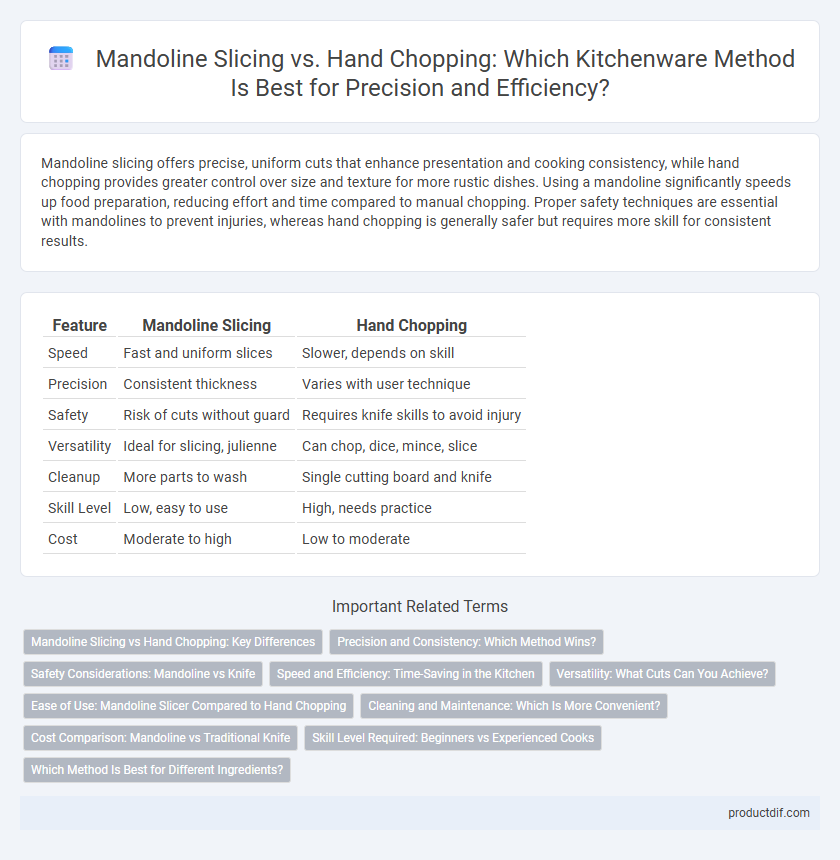Mandoline slicing offers precise, uniform cuts that enhance presentation and cooking consistency, while hand chopping provides greater control over size and texture for more rustic dishes. Using a mandoline significantly speeds up food preparation, reducing effort and time compared to manual chopping. Proper safety techniques are essential with mandolines to prevent injuries, whereas hand chopping is generally safer but requires more skill for consistent results.
Table of Comparison
| Feature | Mandoline Slicing | Hand Chopping |
|---|---|---|
| Speed | Fast and uniform slices | Slower, depends on skill |
| Precision | Consistent thickness | Varies with user technique |
| Safety | Risk of cuts without guard | Requires knife skills to avoid injury |
| Versatility | Ideal for slicing, julienne | Can chop, dice, mince, slice |
| Cleanup | More parts to wash | Single cutting board and knife |
| Skill Level | Low, easy to use | High, needs practice |
| Cost | Moderate to high | Low to moderate |
Mandoline Slicing vs Hand Chopping: Key Differences
Mandoline slicing offers uniform, thin cuts with precise thickness control, enhancing presentation and cooking consistency, unlike hand chopping which may result in uneven pieces. Mandolines significantly reduce preparation time for vegetables and fruits, increasing kitchen efficiency compared to the slower, manual chopping process. However, hand chopping provides greater flexibility for irregular cuts and is safer to use without specialized skills, while mandolines require caution to prevent injury.
Precision and Consistency: Which Method Wins?
Mandoline slicing delivers unmatched precision and consistency by producing uniform slices with adjustable thickness, ideal for presentation and even cooking. Hand chopping depends on the skill and technique of the individual, often resulting in varied sizes and thicknesses that can affect texture and cooking time. For precise, consistent cuts especially in professional kitchens, mandoline slicing is the preferred method.
Safety Considerations: Mandoline vs Knife
Mandoline slicing offers uniform cuts but poses a higher risk of severe cuts due to its sharp, exposed blade and rapid slicing motion, necessitating the use of hand guards or cut-resistant gloves for safety. Hand chopping with a knife provides better control and reduces the chance of accidental injury when proper knife skills are applied, although it requires more attention to technique. While mandolines increase efficiency for consistent slices, prioritizing safety with protective equipment is crucial to prevent common lacerations.
Speed and Efficiency: Time-Saving in the Kitchen
Mandoline slicing dramatically accelerates food preparation by providing uniform slices within seconds, reducing manual effort compared to traditional hand chopping. The precision and consistent thickness achieved with a mandoline enable faster cooking times and enhance dish presentation. Using a mandoline increases kitchen efficiency by minimizing prep time, crucial for busy home cooks and professional chefs alike.
Versatility: What Cuts Can You Achieve?
Mandoline slicers provide precise, uniform cuts such as thin slices, julienne strips, and waffle cuts, enhancing consistency in presentation and cooking times. Hand chopping offers flexibility for irregular, rustic cuts like dicing, mincing, and coarse chopping, ideal for varied textures and recipes. The choice depends on whether precision or adaptability in cut types is prioritized in kitchen tasks.
Ease of Use: Mandoline Slicer Compared to Hand Chopping
Mandoline slicers offer superior ease of use compared to hand chopping by enabling uniform, precise cuts with minimal effort and time. Their adjustable blades allow consistent thickness for vegetables, reducing the physical strain and skill level required. In contrast, hand chopping demands more control and practice to achieve even slices, making mandoline slicers a preferred choice for efficiency and accuracy in meal preparation.
Cleaning and Maintenance: Which Is More Convenient?
Mandoline slicers typically have multiple detachable parts that require thorough cleaning to prevent food residue buildup, making maintenance slightly more time-consuming than hand chopping. Hand chopping involves only a knife and cutting board, both of which are generally easier to clean and dry quickly, minimizing prep and cleanup time. Choosing a mandoline can enhance slicing precision but demands careful dismantling and safe handling during cleaning to avoid blade injuries.
Cost Comparison: Mandoline vs Traditional Knife
Mandolines typically cost between $20 and $100, making them a budget-friendly option for precise, uniform slicing compared to high-quality chef's knives that can range from $50 to over $200. While a traditional knife offers versatility for various kitchen tasks, investing in a mandoline can reduce food preparation time and improve consistency without the need for multiple blades. Considering long-term value, mandolines provide efficient slicing at a lower initial cost, but knives remain essential for broader culinary techniques.
Skill Level Required: Beginners vs Experienced Cooks
Mandoline slicing offers uniform, precise cuts with minimal skill, making it ideal for beginners seeking consistency in kitchenware tools. Hand chopping demands more skill and control, favoring experienced cooks who can adjust cutting techniques for varied textures and presentations. Choosing between mandoline slicing and hand chopping depends on the cook's proficiency and the desired culinary outcome.
Which Method Is Best for Different Ingredients?
Mandoline slicing offers uniform, precise cuts ideal for vegetables like cucumbers, potatoes, and carrots, enhancing presentation and even cooking. Hand chopping provides versatility and control, crucial for ingredients with irregular shapes or delicate textures such as herbs, garlic, and onions. Selecting between mandoline slicing and hand chopping depends on the ingredient's size, texture, and desired cut consistency.
Mandoline slicing vs Hand chopping Infographic

 productdif.com
productdif.com